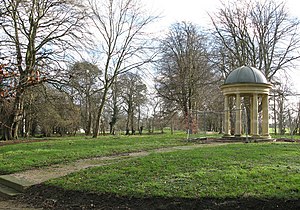Santry Demesne

Santry Demesne (also referred to as Santry Park or Santry Woods) is a demesne in County Dublin, in the north of the county at Santry: a green lung at the edge of the conurbation.
The parkland contains a walled garden. a lake, monuments and is beautified by the Santry River running through it. The park is partly owned by Trinity College Dublin, and in part a country park.
Where the new Santry Demesne public park is situated was once a palatial old house and gardens, built in the 18th century. This was once the largest house in north County Dublin and people travelled from far and wide to be received by the owners, the Barry family.[1] Many clues of the house still exist and the park is worth visiting to find the house foundations, front steps, tree avenue and walled garden. A small bend in the Santry River (which forms the boundary of the park today) was widened to create a small pond for the boating pleasure of Georgian ladies and gentlemen who resided at, and visited, the house.
In 1912 King Victor Emmanuel of Italy presented the Barrys/Domvilles with a gift of 16 foreign tree species.[2]
The house fell into disrepair, initially at the turn of the 20th century as the estate proved not to be economically viable but ultimately after the Domville family departed Ireland post-independence in 1921. It came into the possession of the state, who intended to repair it and use it as a mental asylum. This plan was shelved by the start of Second World War; the need to increase security around Dublin Airport meant it was used as an army depot, and part of the gardens as a firing range. There are many theories locally about what happened next but it appears as if soldiers of the Irish army caused a fire and the house was severely damaged in 1947, followed by demolition shortly afterwards.
In 1972 part of the Demense was sold to Trinity College Dublin, which was developed as a sports grounds, as well as a Book storage facility for its libraries.[3]
In 2010 the walled garden is leased to a community group which runs it as a Community Garden, the 4-acre plot is divided into three sections an ornamental section, heritage and kitchen garden.[4] Many varieties of plants, vegetables and fruit are grown by the 90 volunteers in the garden, since 2013 there is also a bee apiary.
A number of tree species in Santry include native trees such as oak, ash, beech and rowan, as well as the more exotic Spanish chestnuts, Californian redwood (Sequoias), Italian walnut, Lebanon cedar, Horse chestnut, Sweet chestnut, Beech, Ever green Oak, and Chinese Pines.
Description of the house
Santry Court was an important Jacobean type early 18th-century house of red brick and stone facings built in 1703 by 3rd. Lord Barry of Santry, commonly called Lord Santry. Two storeys high over an exceptionally tall basement, and with a dormered attic behind the roof parapet. The dormer windows alternated with segmental and triangular pediments. Facade was 9 bays wide on the entrance front with pedimented breakfront. The front door with segmental pediment and Corinthian columns at the top of a huge flight of steps. Originally the front door was at basement level (the door was relocated to Dublin Castle.) The parapets were partly balustraded with urns at each corner. Curved sweeps and wings were added later, probably 1740–1750. The garden front was also of 9 bays with the wings beyond.
The house had a fine interior, a large hall, with sandstone mantlepiece, and unusually high doors, a staircase of wood with barley sugar balusters, Corinthian newels, and carved acanthus decoration (similar to those at Saunders Grove and Mount Levers). The dining room with plaster panelled walls and a plaster ceiling in low relief, mahogany door frames and dado which were a later addition. The window shutters of oak were probably original. The study was panelled in pine and had a good Adam-style mantlepiece. The morning room had very deep window seats in oak, and corner fireplace. The attic rooms were unusual insofar as the corridor was around the perimeter and the staff bedrooms internal.
A domed temple (garden pavilion) was removed and is retained at Luggala, County Wicklow. A bridge over the river had balustrades and lions. After being gutted in a fire in the 20th century, the house was eventually demolished.
Santry family
The house was built by the 3rd Lord Barry of Santry in 1703. Steps and wings were added by Henry Barry, 4th Baron Barry of Santry 1740–50, who was a member of the Hell Fire Club, and was convicted of the murder of a porter at an inn in Palmerstown 1739. He received the death penalty but was reprieved and lost his title. After the death of Lord Barry of Santry in 1751, the estate was inherited by his uncle Sir Compton Domvile, 2nd Baronet. It remained with the Domvile family until the death in 1935 of Sir Compton Meade Domvile, 4th Baronet, when the estate passed to his nephew Sir Hugo Poë, who assumed the surname Domvile.
Outside links
References
- ↑ Santry House www.dumville.org.
- ↑ History Santry Woods www.geocaching.com
- ↑ Save Santry Wood for the people by Robert Allen, An Phoblacht, November 6, 1997.
- ↑ Santry Community Garden Website